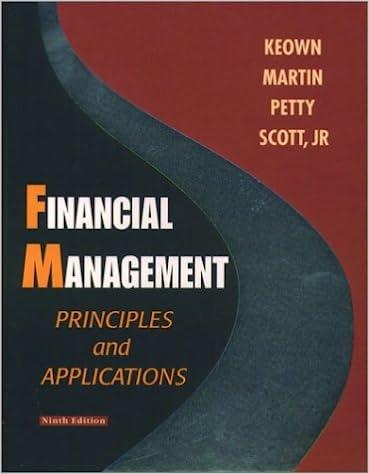Question
P13-1 The initial proceeds per bond, the size of the issue, initial maturity of the bond, and the years remaining to maturity are shown in
| P13-1 The initial proceeds per bond, the size of the issue, initial maturity of the bond, and the years remaining to maturity are shown in following table for a number of bonds. | ||||||||||||||||
| Each bond has a $1,000 par value, and the issuing firm, is in the 35% tax bracket. | ||||||||||||||||
| Bond | Proceeds per Bond | Size of Issue | Initital Maturity of Bond | Years Remaining to Maturity | ||||||||||||
| A | $975 |
| 50,000 Bonds | 10 Years |
| 5 Years |
| |||||||||
| B | 1,020 |
| 25000 Bonds | 20 Years |
| 15 Years |
| |||||||||
| D | 1,000 |
| 100000 Bonds | 25 Years |
|
| 12 Years |
|
| |||||||
| a. Indicate whether each bond was sold at a discount, at a premium, or at its par value. | ||||||||||||||||
| b. Determine the total discount or premium for each issue. | ||||||||||||||||
| c. Determine the annual amount of discount or premium amortized for each bond. | ||||||||||||||||
| d. Calculate the unamortized discount or premium for each bond. | ||||||||||||||||
| e. Determine the after-tax cash flow associated with the retirement now of each of these bonds, using the values developed in part (d). | ||||||||||||||||
Step by Step Solution
There are 3 Steps involved in it
Step: 1

Get Instant Access to Expert-Tailored Solutions
See step-by-step solutions with expert insights and AI powered tools for academic success
Step: 2

Step: 3

Ace Your Homework with AI
Get the answers you need in no time with our AI-driven, step-by-step assistance
Get Started


